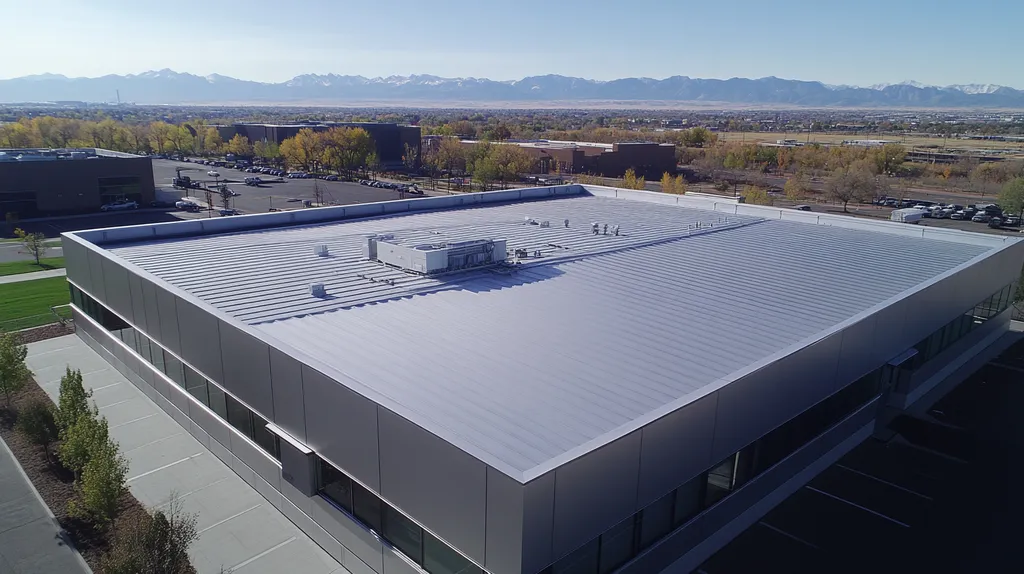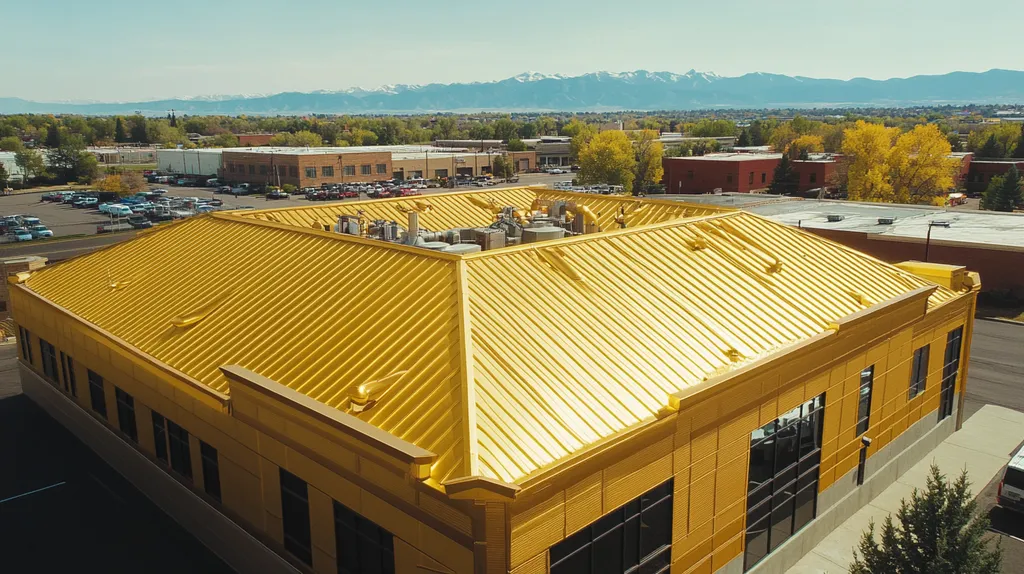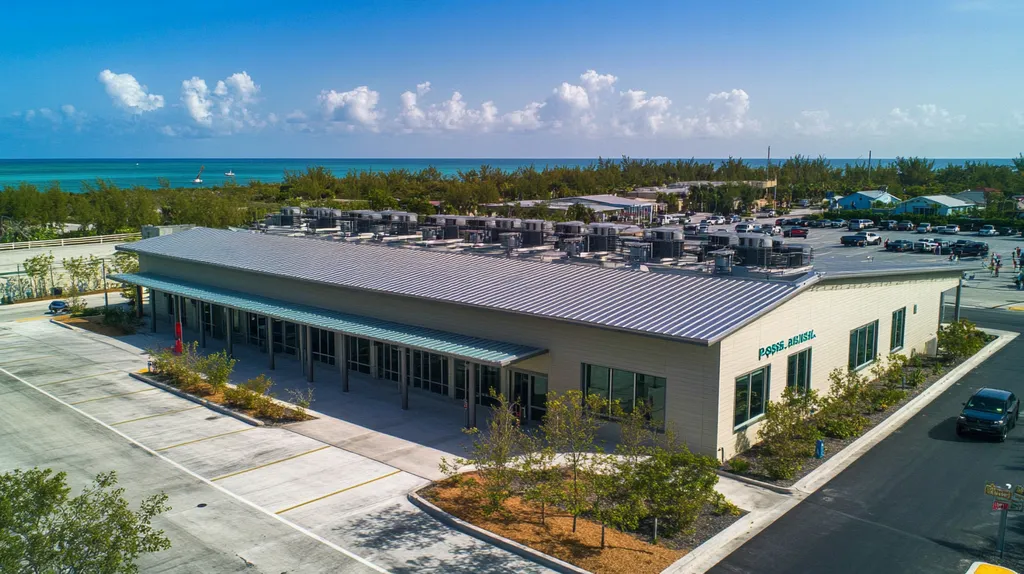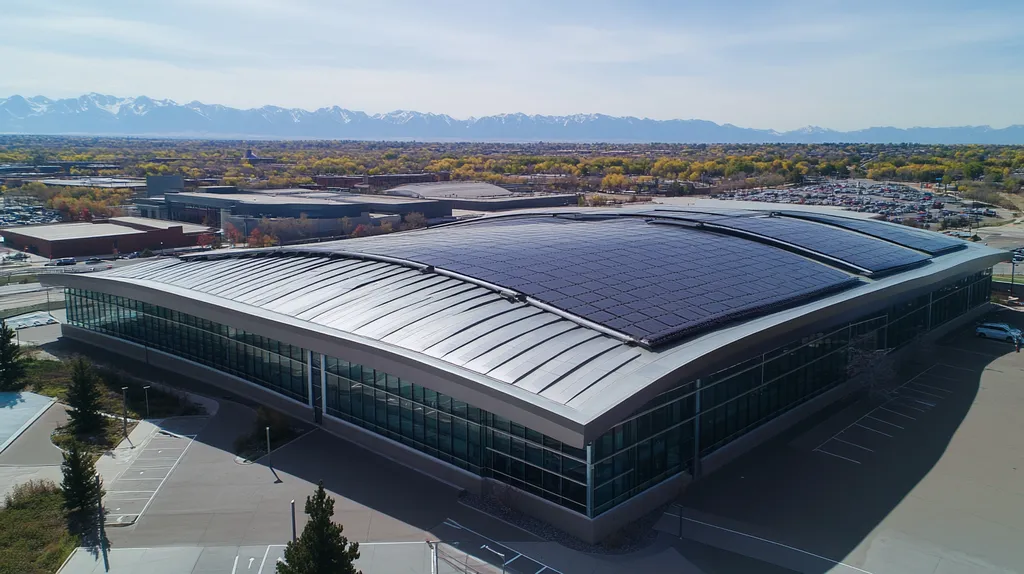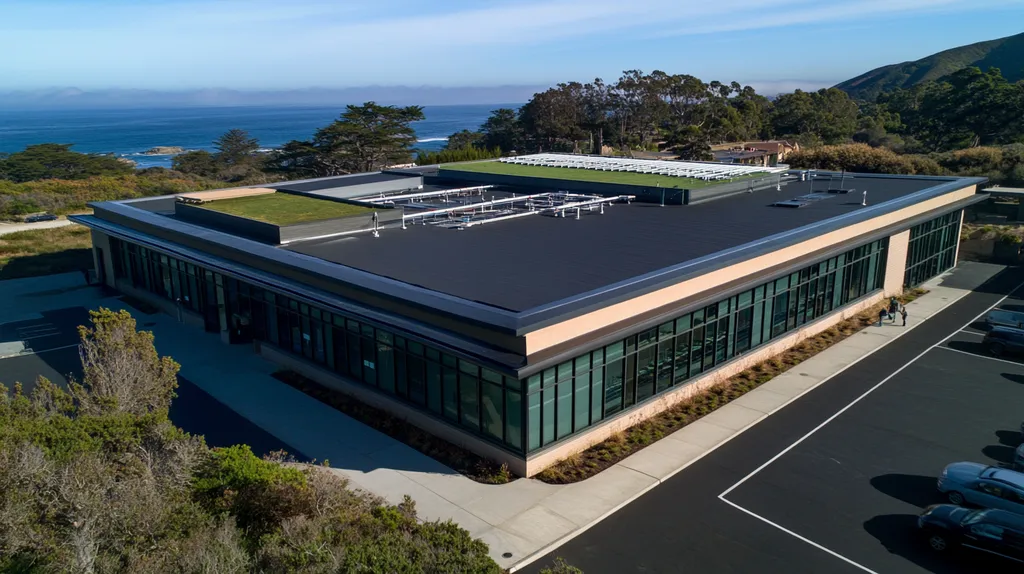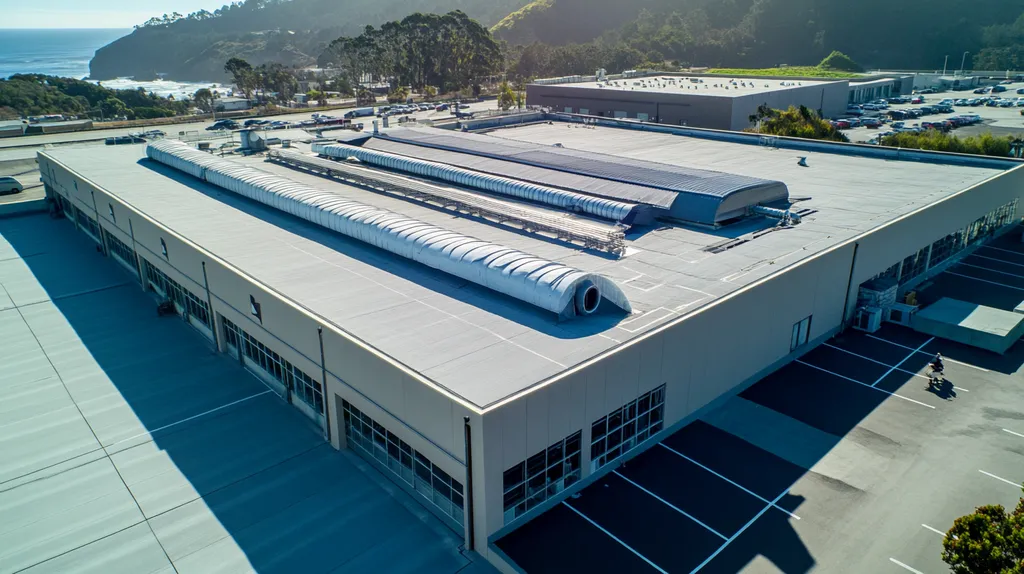In industrial facilities across North America, roof penetrations account for over 85% of catastrophic roof failures, with a single compromised penetration capable of allowing up to 250 gallons of water infiltration annually.
Despite this clear threat, widespread misconceptions about penetration repair continue leading facility managers toward costly mistakes and accelerated roof deterioration.
This comprehensive analysis exposes dangerous industry myths while providing evidence-based solutions for properly maintaining and repairing industrial roof penetrations, potentially saving facilities hundreds of thousands in preventable damage.
SECTION 1: COMMON MISCONCEPTIONS
Roof penetrations represent one of the most vulnerable points in any industrial roofing system, with studies indicating they account for over 85% of all roof leaks. Despite their critical nature, numerous misconceptions persist about how to properly address these potential failure points. These misunderstandings often lead to compromised roof integrity, accelerated deterioration, and significant financial consequences.
Myth: Delaying Repairs Saves Money
When facility managers discover a compromised roof penetration, the temptation to delay repairs for budgetary reasons is strong. However, this approach inevitably leads to more extensive and expensive problems.
Even a small penetration leak can saturate insulation across a much wider area than the visible damage suggests. This hidden spread of moisture can compromise structural integrity and create ideal conditions for mold growth.
The financial impact compounds rapidly – what begins as a simple $500 repair can escalate into a $15,000 replacement project within months if water infiltration continues unchecked.
Additionally, water damage from penetration leaks frequently disrupts operations, leading to lost productivity and potential inventory damage that far exceeds the cost of prompt repairs.
Myth: All Roofing Materials Are Equal
Temporary fixes using basic materials might seem cost-effective, but they rarely provide lasting protection. Different penetration types require specific sealing methods and materials designed for their unique challenges.
While temporary solutions like tarps or basic sealants can stop immediate leaks, they don’t address underlying issues that compromise long-term roof integrity. Permanent solutions such as pitch pockets, pipe boots, and compression seals are essential for lasting protection.
The choice of permanent sealing method must match both the penetration type and environmental conditions. Regular maintenance remains necessary even with premium materials to ensure continued effectiveness.
Selecting appropriate materials and techniques for specific penetration types significantly impacts long-term performance and maintenance requirements. (source: O’Connor Roofing)
Myth: DIY Repairs Are Safe and Effective
The complexity of industrial roofing systems makes DIY repairs particularly risky. Each penetration interacts with multiple roofing components, requiring detailed technical knowledge for proper repair.
Incorrect repair techniques can void manufacturers’ warranties and create new paths for water infiltration. Even experienced maintenance staff may lack the specialized training needed for proper penetration repairs.
Safety considerations make professional expertise essential. Working around roof penetrations often requires specialized fall protection equipment and protocols that most facilities don’t maintain.
The liability risks associated with improper repairs or workplace accidents typically far outweigh any perceived cost savings from DIY approaches.
SECTION 2: PRACTICAL IMPLICATIONS
Roof penetrations represent critical vulnerabilities that demand immediate attention in industrial facilities. Studies show that a single quarter-sized penetration can allow up to 250 gallons of water infiltration annually. Beyond the immediate structural concerns, these seemingly minor issues cascade into major operational challenges, affecting everything from energy costs to workplace safety. Understanding these practical implications helps facility managers make informed decisions about maintenance priorities and repair investments.
Ignoring Small Leaks Leads to Major Damage
Even minor penetration leaks can trigger a devastating chain reaction within industrial roofing systems. Water entering through small openings follows paths of least resistance, often traveling significant distances before showing visible signs of damage.
The financial impact escalates rapidly as water compromises successive roofing layers. What begins as simple deterioration of sealants can progress to saturated insulation, corroded fasteners, and compromised structural components within months.
Temperature fluctuations cause these openings to expand and contract, progressively widening the breach. This cycle accelerates during freeze-thaw periods, turning pinhole leaks into major structural concerns.
Manufacturing processes generating heat or humidity amplify these effects, as moisture-laden air seeks escape routes through compromised penetrations. This creates a continuous cycle of degradation that compounds existing damage.
Impact on Building Insulation and Energy Efficiency
Compromised roof penetrations create thermal bridges that bypass insulation systems. These breaches allow conditioned air to escape while permitting outside air infiltration, dramatically reducing HVAC efficiency.
Moisture infiltration through penetrations can reduce insulation R-value by up to 40% in affected areas. This degradation spreads well beyond the visible damage zone, creating widespread thermal inefficiency.
Energy costs typically increase 15-25% in facilities with compromised penetrations as HVAC systems struggle to maintain consistent temperatures. This impact becomes particularly severe in facilities with sensitive climate control requirements.
The combination of reduced insulation effectiveness and increased air infiltration creates unstable interior environments. These conditions can affect production processes, product quality, and equipment performance.
Safety Risks of Unaddressed Penetrations
Unrepaired penetrations create significant workplace safety hazards beyond their structural implications. Water infiltration leads to slip hazards on walking surfaces and can compromise fall protection anchor points.
Electrical systems near compromised penetrations face increased risk of short circuits and fire hazards. This danger intensifies in facilities where roof penetrations service electrical equipment or house conduit runs.
Moisture accumulation from leaking penetrations creates ideal conditions for mold growth. Industrial facilities with climate-controlled environments are particularly susceptible to rapid mold spread, threatening worker health.
The added weight of water-saturated materials can exceed design load limits in affected areas. This structural stress becomes particularly dangerous during snow events or when mechanical equipment requires roof access.
SECTION 3: COST OF MISINFORMATION
The financial impact of misunderstanding roof penetration maintenance creates a devastating cascade effect for industrial facilities. A single compromised penetration can allow thousands of gallons of water infiltration annually, leading to structural damage that compounds exponentially. Industry data shows that postponing basic penetration repairs typically multiplies the final repair costs by 15-20 times the original estimate, while simultaneously increasing operational disruptions and safety risks.
Financial Consequences of Delayed Repairs
When facility managers postpone penetration repairs, they often face escalating costs that far exceed initial repair estimates. What begins as a simple $500 repair can quickly evolve into a $15,000 rehabilitation project within a single season.
Emergency repairs during adverse weather conditions typically cost 3-4 times more than scheduled maintenance. These urgent interventions often require overtime labor and expedited material delivery, further inflating costs.
The hidden costs extend beyond direct repairs to include increased energy consumption, as compromised penetrations reduce HVAC efficiency by up to 40%. This inefficiency directly impacts monthly utility expenses.
Business interruption costs often dwarf the actual repair expenses, with production delays and inventory damage frequently reaching tens of thousands of dollars per incident.
Cost of Water Damage and Structural Issues
Water infiltration through compromised penetrations creates a destructive chain reaction throughout roofing systems. Initial moisture intrusion can saturate large sections of insulation and roofing materials, requiring extensive replacement rather than simple repairs.
Structural steel components exposed to consistent moisture can experience accelerated corrosion, potentially requiring engineering assessment and reinforcement. These structural interventions often cost 5-10 times more than immediate penetration repairs.
The presence of moisture creates ideal conditions for mold growth, leading to expensive remediation requirements. A single mold outbreak can cost upwards of $25,000 to address properly.
Water seeping through damaged roof penetrations can saturate multiple roofing layers, requiring complete replacement of affected sections. Solutions GC notes that proper drying techniques and timely repairs are essential to prevent cascading damage that leads to more extensive repairs. (source: Solutions GC)
Loss of Warranty Due to Neglect
Most commercial roofing warranties require regular maintenance and prompt repair of penetrations. Failing to address these issues typically voids warranty coverage, leaving facility owners fully responsible for replacement costs.
The financial impact of a voided warranty can exceed $100,000 for larger industrial facilities, as manufacturers will deny claims related to water damage stemming from neglected penetrations.
Documentation requirements for warranty compliance often specify maximum response times for addressing penetration issues. Exceeding these windows invalidates coverage, even if repairs are eventually completed.
Many warranties include specific maintenance protocols for different types of penetrations. Deviation from these requirements, even with good intentions, can result in complete warranty cancellation.
SECTION 4: REALITY CHECK
Industrial roof penetrations represent critical vulnerabilities that demand systematic attention and expertise. Studies show that facilities implementing regular inspection programs reduce their emergency repair costs by up to 70% compared to reactive maintenance approaches. Yet over 60% of industrial facilities still lack comprehensive penetration maintenance protocols, leading to premature roof failures and exponential repair costs.
Importance of Regular Roof Inspections
Professional roof inspections must occur at least twice annually, with additional checks following severe weather events. These evaluations help identify deteriorating seals, compromised flashing, and other penetration vulnerabilities before water infiltration occurs.
Documentation from each inspection creates a valuable historical record that helps track degradation patterns and predict potential failure points. This data enables facilities to develop targeted maintenance strategies that prevent catastrophic failures.
Thermal imaging and moisture mapping during inspections can reveal hidden water infiltration around penetrations that visual inspections might miss. Early detection through these methods typically reduces repair costs by 60-80%.
While inspections require initial investment, they consistently deliver returns exceeding 300% through prevented damage and extended roof life. Proper documentation also helps maintain warranty coverage and compliance with insurance requirements.
Distinguishing Between Repair and Replacement Needs
Effective penetration maintenance requires clear criteria for determining appropriate intervention levels. Small breaches caught early often require only minor repairs, while delayed maintenance typically forces complete system replacement.
Highly corroded or damaged flashing demands immediate replacement rather than attempted repairs. These situations require removing multiple rows of roofing material to access and properly replace compromised components.
The age and condition of surrounding roofing materials significantly impact repair versus replacement decisions. Areas with multiple failing penetrations often indicate systemic issues requiring comprehensive solutions rather than spot repairs.
Professional assessment should evaluate both immediate penetration issues and long-term roof integrity. Solutions GC emphasizes that proper flashing replacement requires accessing the base materials and applying appropriate sealants for lasting protection. (source: Solutions GC)
Specialized Care for Different Roof Materials
Different roofing systems require specific penetration maintenance approaches based on their material composition and installation methods. Single-ply membranes need specialized sealants and application techniques that differ substantially from built-up roofing requirements.
Temperature fluctuations affect various roofing materials differently, requiring seasonal adjustments to maintenance protocols. Metal roofs demand particular attention to thermal movement around penetrations to prevent separation and leaks.
Chemical exposure from industrial processes can accelerate deterioration around penetrations, necessitating material-specific protective measures. Facilities must match repair materials and methods to their specific roofing system to ensure compatibility.
Regular evaluation of sealant and flashing conditions helps identify material-specific wear patterns. This knowledge enables facilities to optimize maintenance intervals and select appropriate repair materials for their specific roofing system.
SECTION 5: EVIDENCE-BASED ALTERNATIVES
Industrial roof penetrations represent critical vulnerabilities that demand systematic attention, with studies showing they account for up to 85% of all roof failures. The financial stakes are significant – a single compromised penetration can result in damages exceeding $50,000 when repair is delayed. Yet many facilities continue relying on outdated or ineffective maintenance approaches, leading to premature system failures and unnecessary capital expenses.
Proactive Maintenance Schedules
Implementing structured maintenance schedules represents the foundation of effective penetration management. Data shows that facilities with documented inspection protocols experience 70% fewer emergency repairs compared to those using reactive approaches.
These schedules must align with seasonal challenges, incorporating additional inspections after severe weather events. Special attention should focus on penetration points showing early signs of deterioration or those exposed to harsh industrial conditions.
Documentation plays a crucial role, creating traceable records of inspections, repairs, and material conditions. This historical data enables facilities to identify recurring issues and optimize maintenance intervals.
Regular cleaning and debris removal around penetrations prevents water pooling that accelerates deterioration. Even minor maintenance tasks contribute significantly to extending system lifespan when performed consistently.
Hiring Qualified Roofing Contractors
Selecting properly certified and experienced contractors dramatically impacts penetration repair outcomes. Professional expertise ensures proper material selection and installation techniques that align with manufacturer specifications.
Qualified contractors bring specialized knowledge about system compatibility and proper flashing installation. Their expertise helps prevent common failures that occur when inexperienced teams attempt complex penetration repairs.
Professional teams maintain comprehensive insurance coverage and provide meaningful warranties. These protections safeguard facility owners from liability while ensuring accountability for workmanship.
Experienced contractors also understand the importance of proper documentation for warranty compliance. Their systematic approach helps maintain manufacturer coverage throughout the roof’s service life.
Regular Flashing Inspections and Replacement
Proper flashing maintenance forms the cornerstone of effective penetration protection. Visual inspections must occur quarterly, with detailed assessments of sealant conditions and material integrity.
When deterioration is identified, complete replacement often proves more cost-effective than attempted repairs. Proper flashing replacement requires removing multiple rows of roofing material to access and properly reseal compromised components.
Advanced diagnostic tools like infrared scanning help identify hidden moisture infiltration around flashings. Early detection through these methods typically reduces repair scope and preserves surrounding materials.
Professional assessment should evaluate both immediate flashing issues and long-term integrity factors. Solutions GC emphasizes that comprehensive flashing replacement requires accessing base materials and applying appropriate sealants for lasting protection. (source: Solutions GC)
SECTION 6: TEST AND VERIFY
Industrial roof penetration repairs demand rigorous verification to ensure long-term effectiveness. Studies show that up to 40% of penetration repairs fail within the first year due to inadequate testing and documentation. This failure rate multiplies repair costs while exposing facilities to unnecessary risks. Implementing systematic verification protocols transforms uncertain outcomes into reliable, warranted solutions that protect both the facility and its operations.
Conducting Thorough Roof Assessments
Post-repair verification must begin with comprehensive water testing that simulates actual storm conditions. This testing should last a minimum of 30 minutes per penetration, with observers positioned both above and below the repair site to detect any water infiltration.
Thermal imaging scans provide crucial data about repair integrity by revealing hidden moisture patterns and thermal bridging. These scans should extend at least 10 feet beyond the visible repair area to ensure no secondary leakage points exist.
Physical inspection of sealant adhesion and flashing integration must occur 24-48 hours after repair completion. This timing allows materials to fully cure while enabling early detection of bonding failures or material incompatibilities.
Documentation through high-resolution photos and detailed measurements creates a baseline for future comparisons. This visual record proves especially valuable for warranty claims and maintenance planning.
Verifying Contractor Credentials and Insurance
Contractor verification must extend beyond basic licensing to include specific certifications for the installed roofing systems. Major manufacturers require specialized training for warranty-approved installations, particularly around critical penetrations.
Insurance coverage verification should include both general liability and specific riders for roofing work. Standard policies often exclude certain types of roof work, making additional coverage essential for complete protection.
Safety protocols and compliance history deserve careful scrutiny, as accidents around penetrations often result from inadequate preparation or shortcuts. Request detailed safety plans specifically addressing penetration work procedures.
References should focus specifically on similar penetration repairs completed within the past 18 months. This timeframe provides relevant insight into current capabilities while allowing sufficient time to evaluate repair durability.
Documenting Maintenance for Warranty Compliance
Warranty protection requires systematic documentation of all penetration-related activities. Create detailed logs recording inspection dates, findings, repair methods, and materials used for each penetration point.
Photographic documentation must capture conditions before, during, and after all maintenance activities. These images should include wide shots showing context and close-ups revealing specific repair details.
Material specifications and application details need precise documentation to demonstrate compliance with manufacturer requirements. Save all product data sheets, mixing ratios, and application temperatures as part of the permanent record.
Establish clear maintenance intervals based on manufacturer recommendations and local climate conditions. Document these schedules and maintain records of actual service dates to demonstrate consistent compliance.
The Bottom Line
With penetration failures causing 85% of catastrophic roof damage and average repair costs exceeding $50,000 when left unaddressed, the stakes for proper maintenance couldn’t be higher.
The evidence consistently shows that proactive penetration maintenance, when properly implemented, reduces emergency repairs by 70% while extending roof life by up to 40%.
Regular inspections, qualified contractors, and proper documentation form the essential foundation for protecting industrial roofing investments.
Facility managers who embrace evidence-based maintenance protocols, rather than relying on industry myths, position their organizations to avoid the devastating cascade of structural damage, operational disruptions, and financial losses that stem from compromised roof penetrations.
The choice between proactive protection and reactive repairs ultimately determines whether penetrations become points of failure or proven assets in facility management.
FREQUENTLY ASKED QUESTIONS
Q. What are common misconceptions about commercial roof penetrations?
A. Many believe that delaying repairs saves money, but this often leads to larger issues. Small leaks can turn into major catastrophes, escalating repair costs significantly. It’s crucial to address penetrations promptly to prevent further damage, ensuring long-term savings and roof integrity.
Q. How do industrial roof penetrations impact energy efficiency?
A. Penetrations can create thermal bridges that reduce insulation effectiveness and increase energy costs. This inefficiency can lead to a significant rise in HVAC usage and monthly utility bills. It’s essential to maintain these areas to uphold a comfortable work environment and control energy expenses.
Q. What are the financial consequences of misinformation on industrial roof maintenance?
A. Delaying necessary maintenance due to misinformation can lead to astronomical costs. Initial minor repairs can escalate tremendously, resulting in emergency replacement expenses that far exceed the original estimates. Understanding proper maintenance prevents unnecessary financial burdens and operational disruptions.
Q. Why are regular inspections important for commercial roofs?
A. Consistent inspections help identify vulnerabilities before they escalate into major problems. Facilities performing regular checks can reduce emergency repair costs significantly. Documenting these inspections also assists with long-term planning, compliance, and warranty requirements, promoting a healthier roof system.
Q. How can facility managers evaluate repair versus replacement needs?
A. Effective evaluations require assessing the extent of damage and surrounding materials. Minor penetrations may warrant simple repairs, while severe deterioration often indicates the need for replacement. Consulting with professionals allows for informed decisions that enhance long-term roofing outcomes.
Q. What should be considered when hiring roofing contractors?
A. Look for licensed and insured contractors with specialized training in roofing systems. Experienced professionals understand material compatibility and installation techniques crucial for effective repairs. Their track record of successful projects, along with warranty assurance, ensures reliable outcomes for penetration maintenance.
Q. How do I verify successful roof repairs?
A. Thorough assessments post-repair involve water testing, thermal imaging, and physical inspections. These methods ensure the repair’s integrity and identify any potential issues before they cause further problems. Documenting repair conditions helps maintain standards and compliance with warranties.

